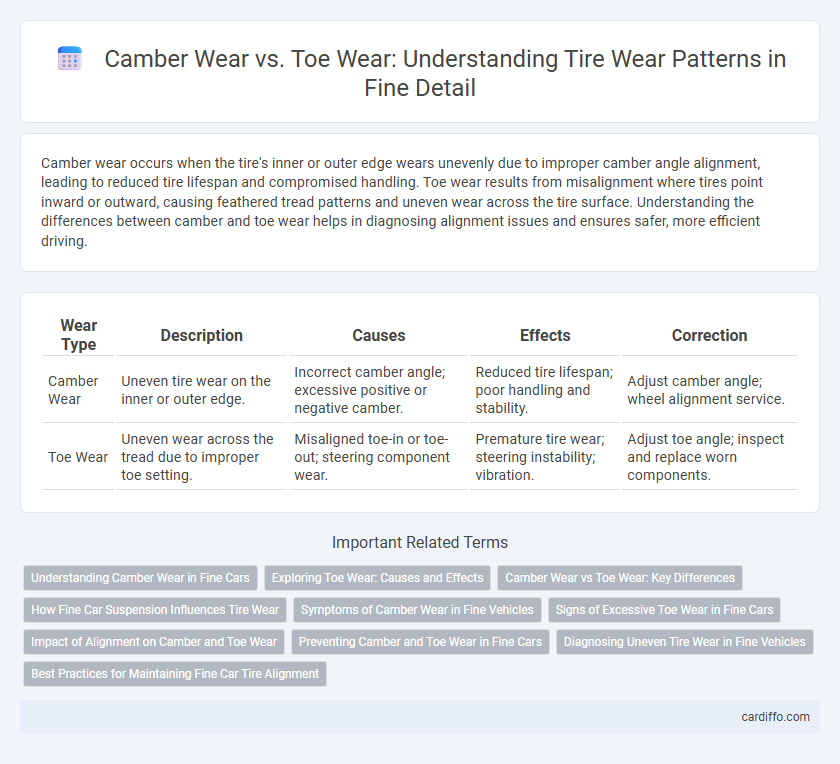Camber wear occurs when the tire's inner or outer edge wears unevenly due to improper camber angle alignment, leading to reduced tire lifespan and compromised handling. Toe wear results from misalignment where tires point inward or outward, causing feathered tread patterns and uneven wear across the tire surface. Understanding the differences between camber and toe wear helps in diagnosing alignment issues and ensures safer, more efficient driving.
Table of Comparison
| Wear Type | Description | Causes | Effects | Correction |
|---|---|---|---|---|
| Camber Wear | Uneven tire wear on the inner or outer edge. | Incorrect camber angle; excessive positive or negative camber. | Reduced tire lifespan; poor handling and stability. | Adjust camber angle; wheel alignment service. |
| Toe Wear | Uneven wear across the tread due to improper toe setting. | Misaligned toe-in or toe-out; steering component wear. | Premature tire wear; steering instability; vibration. | Adjust toe angle; inspect and replace worn components. |
Understanding Camber Wear in Fine Cars
Camber wear in fine cars occurs when the wheel tilts inward or outward, causing uneven tire tread wear primarily on the inner or outer edges. Proper camber alignment ensures optimal tire contact with the road, enhancing handling, stability, and tire longevity in high-performance luxury vehicles. Regular inspection and adjustment of camber settings prevent premature tire wear and maintain precise vehicle dynamics.
Exploring Toe Wear: Causes and Effects
Toe wear occurs when the front edge of a tire experiences excessive friction, often caused by improper toe alignment settings such as toe-in or toe-out angles. This abnormal wear pattern reduces tire lifespan, destabilizes steering response, and may increase tire noise. Correcting toe alignment ensures even tire contact with the road surface, improving vehicle handling and safety.
Camber Wear vs Toe Wear: Key Differences
Camber wear primarily occurs on the inner or outer edges of the tire tread due to incorrect camber alignment, causing uneven pressure distribution during cornering. Toe wear, on the other hand, manifests as feathered or scalloped tread patterns caused by misaligned wheels pointing inward or outward, affecting tire longevity and vehicle handling. Understanding the difference between camber wear and toe wear is essential for accurate suspension diagnostics and maintaining optimal tire performance.
How Fine Car Suspension Influences Tire Wear
Fine car suspension tuning directly impacts tire wear patterns by optimizing camber and toe angles for each driving condition. Proper camber adjustment ensures even tire contact with the road, minimizing camber wear on the inner or outer edges of the tire. Accurate toe alignment reduces uneven toe wear caused by excessive scrubbing during turns, extending tire life and enhancing overall vehicle handling.
Symptoms of Camber Wear in Fine Vehicles
Camber wear in fine vehicles typically presents as uneven tire tread wear, with the inner or outer edges of the tires wearing out faster than the center. This uneven wear results in reduced tire lifespan and can cause noticeable pulling to one side while driving. Additionally, symptoms include decreased handling performance and increased road noise, indicating the need for alignment adjustments to restore optimal tire contact and vehicle stability.
Signs of Excessive Toe Wear in Fine Cars
Excessive toe wear in fine cars typically presents as uneven tire tread wear concentrated on the inner or outer edges of the tires, often causing premature tire replacement. This wear pattern can lead to compromised handling and increased road noise, signaling improper toe alignment. Monitoring these signs enables timely adjustments to ensure optimal tire performance and vehicle stability.
Impact of Alignment on Camber and Toe Wear
Misalignment in vehicle suspension significantly influences camber and toe wear, causing uneven tire degradation. Excessive positive or negative camber leads to accelerated wear on one tire edge, while incorrect toe settings result in feathered tire patterns and increased tread wear. Proper alignment adjustments optimize tire contact patches, enhancing tire lifespan and improving overall vehicle handling.
Preventing Camber and Toe Wear in Fine Cars
Preventing camber and toe wear in fine cars relies on precise wheel alignment and regular suspension inspections to maintain optimal tire contact with the road. Using high-quality alignment tools and adjusting the camber and toe angles within manufacturer specifications reduces uneven tire wear and enhances vehicle handling. Routine maintenance, including checking for worn suspension components, ensures consistent alignment and prolongs tire life in luxury and performance vehicles.
Diagnosing Uneven Tire Wear in Fine Vehicles
Diagnosing uneven tire wear in fine vehicles requires analyzing camber wear, which occurs when the tire tilts inward or outward causing wear on one edge, and toe wear, caused by misalignment resulting in feathered or scalloped tread patterns. Camber wear typically indicates suspension issues or bent components affecting wheel alignment, while toe wear signals problems with steering or alignment settings. Precise alignment measurements using advanced diagnostic tools help identify whether camber or toe settings need correction to optimize tire life and vehicle handling.
Best Practices for Maintaining Fine Car Tire Alignment
Proper tire alignment extends the lifespan of car tires by minimizing uneven tread wear such as camber wear and toe wear. Regularly inspecting and adjusting camber angles prevents excessive inner or outer edge tread wear, while correct toe settings ensure tires roll parallel, reducing feathering and scrubbing. Scheduling professional alignment checks every 10,000 to 12,000 miles optimizes handling, fuel efficiency, and safety by maintaining precise camber and toe specifications.
Camber wear vs Toe wear Infographic

 cardiffo.com
cardiffo.com